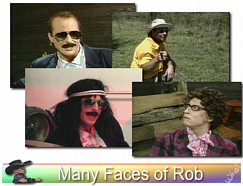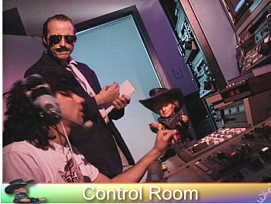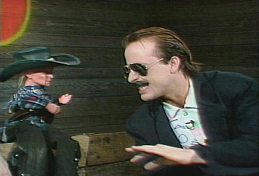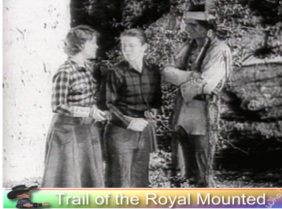|
 As those familiar with television production may know, most series are in 13-week blocks, so a season might be 13, 26, or 39 episodes. This first contracted season was indeed 13 episodes, which might confuse owners of the Season 1 DVD since there are only 12. By way of explanation, at the time we were planning and shooting Season 1 we were extremely confident that we were going to be doing Season 2 and so planned the season accordingly. The primary storyline of Season 1 ends with a rather remarkable transition that calls for a fairly fundamental change in set and story elements, so we decided to make the last episode a sort of recap/reorientation show. In publishing on DVD we decided to shift this episode to the beginning of Season 2, and now Season 1 ends on a suitably ambiguous and intriguing cliffhanger. As those familiar with television production may know, most series are in 13-week blocks, so a season might be 13, 26, or 39 episodes. This first contracted season was indeed 13 episodes, which might confuse owners of the Season 1 DVD since there are only 12. By way of explanation, at the time we were planning and shooting Season 1 we were extremely confident that we were going to be doing Season 2 and so planned the season accordingly. The primary storyline of Season 1 ends with a rather remarkable transition that calls for a fairly fundamental change in set and story elements, so we decided to make the last episode a sort of recap/reorientation show. In publishing on DVD we decided to shift this episode to the beginning of Season 2, and now Season 1 ends on a suitably ambiguous and intriguing cliffhanger.
In fact as the three of us met to conceptualize the story arc of the series it was all pretty clear that in fact Series 1 was going to serve as the "launch" for the rest of the series, and we were all pretty sure we would have at least 2 seasons.
By the time we were ready to go into production, CHRO had moved its facilities, to a building that was not a great improvement in terms of space but presumably lower in rent. They did, however upgrade all their equipment to Betacam SP. This meant that most of the pilot would have to be re-shot to match later quality, even if we didn’t want to do the first episode again. Actually, we ended up keeping original versions of the ads in the first episode, which adds an extra subtle level of "cheesiness" to them, and the Trail of the Royal Mounted, where image quality is not a quality element.
 And so we rebuilt the set, slightly larger than in the pilot, but with most of the same materials. We laid out a 2-week shooting schedule for the studio material for Season 1, which was the only section of the series done with a full crew. Pretty all the names in the crew credits on each episode are the fine gentlemen who were with us for those ten shooting days. A couple of guest performers had to be cast, Cowboy Pat rebooked, several costumes to prepare (mostly for Rob to wear). And so we rebuilt the set, slightly larger than in the pilot, but with most of the same materials. We laid out a 2-week shooting schedule for the studio material for Season 1, which was the only section of the series done with a full crew. Pretty all the names in the crew credits on each episode are the fine gentlemen who were with us for those ten shooting days. A couple of guest performers had to be cast, Cowboy Pat rebooked, several costumes to prepare (mostly for Rob to wear).
The show fell down into three primary production areas: The studio segments, shot in the short period referred to above (all of which was fully scripted by Mike based on the story outlines we had come up with in group meetings), the Professor Dave material (based on handycam footage Rob had shot on a vacation in Africa, and in season 1 edited and voiced by Rob), and everything else, which was my territory, and mostly filler segments drawing on public domain material (like Trail of the Royal Mounted) and fake ads.
The studio stuff was shot as self-contained sequences with live switching*. Rob sequestered himself in an edit suite and spent many days editing his Professor Dave sequences from the tens of hours of footage he had shot. Mike’s primary involvement was writing, and in a few weeks he had turned out the full scripts for the main studio material.
| *Live Switching is the process of editing "on-the-fy". You cover some event or a TV show using multiple cameras set for multiple video angles. Then instead of letting each camera record on a separate tape you feed all the cameras into a level mixer or video switcher. The technical director who is sitting in control room does all the cuts live (even if the show isn’t live at all!) and simply record the output to one tape. This eliminates the big chunk of post production and allows for using more cameras and more angles (some cameras can be left unmanned for example for wide shots). TV studios literally love live switching techniques for any live or non-live events, even for typical TV shows because they have seldom much time to spend on any post production. Only in recent years with affordable powerhouse NLE and also more money coming towards TV the shows are being produced more film-like with full postproduction. |
It must be said here that this was all marvelous script with many original ideas that did not come out of the story sessions. He has a great mind for bringing an appealing child-like voice to the storytelling while hinting at a darker ironic cynicism just below the surface (best expressed in the wonderful Sally Polkadot stories of season 2). As we got more comfortable, a certain level of improvisation entered the work, but for the most part the scripts in traditional theatrical fashion had to be memorized by the principals. Well at least most of them.
 It must be understood at this point that both Mike and I did not consider ourselves performers. Though I had done radio voice work and he had been in a theater troupe I thought of myself as a producer and he as a writer. However, our proposed budget for this show did not leave room for us to pay more full-time participants than the three of us, so we became what we referred to as “default performers”. Mike took on the role of the vaguely-engaged late-teen who is reluctantly thrown into the primary host position, which put him in almost every studio scene. Rob, who had the most performance experience, was in fact the only one of us with any acting union affiliation and actual hopes for an acting career, and so he was given almost every character role in the studio material "O’Really, Phyllis, Jinglebelly, Blando" If you look at the front of the DVD the vast majority of images there are of Rob. But this left the puppet, the central figure onscreen, the key character-with-a-secret, that must somehow transition from a believable sidekick to a fantasy creature. (We’ll leave out here the obvious on-the-face absurdity of a "puppet" being a character at all, that the humans somehow notice his apparently impossible physical nature, and reference aspects of it, without somehow understanding its implications) It must be understood at this point that both Mike and I did not consider ourselves performers. Though I had done radio voice work and he had been in a theater troupe I thought of myself as a producer and he as a writer. However, our proposed budget for this show did not leave room for us to pay more full-time participants than the three of us, so we became what we referred to as “default performers”. Mike took on the role of the vaguely-engaged late-teen who is reluctantly thrown into the primary host position, which put him in almost every studio scene. Rob, who had the most performance experience, was in fact the only one of us with any acting union affiliation and actual hopes for an acting career, and so he was given almost every character role in the studio material "O’Really, Phyllis, Jinglebelly, Blando" If you look at the front of the DVD the vast majority of images there are of Rob. But this left the puppet, the central figure onscreen, the key character-with-a-secret, that must somehow transition from a believable sidekick to a fantasy creature. (We’ll leave out here the obvious on-the-face absurdity of a "puppet" being a character at all, that the humans somehow notice his apparently impossible physical nature, and reference aspects of it, without somehow understanding its implications)
So as the only one left, it ended up that I became the puppeteer. I had done some playing with marionettes as a kid, once put on a complex marionette show for all the campers at my entire summer camp, but had certainly no professional puppetry in my background. The advantage of being the puppeteer is that I could watch a monitor, which made it easy to direct (though all live camera switching was done by the station crew director). Also, it meant I didn’t have to memorize script but could have it mounted in front of me. Ironically, even though I was reading script, I probably made more mistakes than my two acting comrades (probably because I was actually watching TV, as it were).
| Michael Cormier comment: Jeff did far more than merely flip switches for Cowboy Who? He directed all of the scenes on set while lying on the floor, watching a monitor, and playing the loveable puppet sidekick Smilin’ Tom at the same time. He was also single-handedly responsible for “Trail of the Royal Mounted”, a re-voiced, old black-and-white cowboy serial that aired as a regular feature on our show. Other than Steve Martin’s Dead Men Don’t Wear Plaid, I personally have never seen a comedy voice over-dub done with such care and creativity. And I’ve seen plenty. |
 In addition to the studio material, which probably comprised a little over half of the full show content, there were sequences shot in the "control room", which was the actual edit suite where I did all the editing. In addition to the studio material, which probably comprised a little over half of the full show content, there were sequences shot in the "control room", which was the actual edit suite where I did all the editing.
This material was usually shot with two cameras, one locked off shooting from the studio through the window, and one a hand held managed by one of the crew. These were recorded to separate tapes and edited later. We spent only a couple of days on this material. Then there were the ENG shoots, so-called because they involved one crew member and were shot the same way as they typically shot news items (Electronic News Gathering). We did the ads in season 1 this way (Kitchen Hammer, Crazy Eddie’s, Fitness Rope, etc.). These as well were all done in a couple of days, most of them shot in our own homes (or in the case of the car dealership ad, in the parking lot next door to the TV station).
Another significant chunk of the show was comprised of found footage, most of which was public domain material I had secured from the Canadian Public Archives. My interaction with the Archives turned out to be a fortuitous bit of timing, since not long after I got material from them they instituted extremely steep user fees.
 At the time I approached them it was still possible to get anything that was in the public domain from the collection without cost, all you had to do was show up with the tapes (Umatic ¾” cassettes). First, however, I had to go through their entire catalogue to find material I was interested in, which took several days. At the end of that time I delivered to them a long list of items I thought might be useful, concentrating on animation, and, well, anything with promise in its description. The Archive researchers would then determine “provenance”, meaning whether anybody now held copyright for it, which would mean we couldn’t have it. One item I was very excited about was the Winsor McCay animations… McCay was one of the world’s first animators, was most famous for his “Little Nemo” comic strip in the early 1900’s but also produce the very first successful animation in 1913, “Gertie the Dinosaur”. The archives had about 12 minutes of his early animations in the catalogue, but the researchers said they were not in the public domain, that ownership was retained by McCay’s family. They did however have a contact number. I called it, and ended up speaking with Winsor’s granddaughter. I told her the story, asked if we could use the material, she sounded hopeful, said she would get back to me. I sat on pins and needles for three days until I heard from her, but the answer was no. I was disappointed. It would have been a major coup to get the use of that footage. However, in retrospect I would have to say that it is a good thing we didn’t acquire those clips. Their historical value would have made them stand out from everything else onscreen, which is all pretty well material that will be universally unknown to a first-time viewer. Right now there is very little in the series that places it accurately in the real media world, this would have been a clear marker for anybody familiar with the history of animation and a huge distraction. At the time I approached them it was still possible to get anything that was in the public domain from the collection without cost, all you had to do was show up with the tapes (Umatic ¾” cassettes). First, however, I had to go through their entire catalogue to find material I was interested in, which took several days. At the end of that time I delivered to them a long list of items I thought might be useful, concentrating on animation, and, well, anything with promise in its description. The Archive researchers would then determine “provenance”, meaning whether anybody now held copyright for it, which would mean we couldn’t have it. One item I was very excited about was the Winsor McCay animations… McCay was one of the world’s first animators, was most famous for his “Little Nemo” comic strip in the early 1900’s but also produce the very first successful animation in 1913, “Gertie the Dinosaur”. The archives had about 12 minutes of his early animations in the catalogue, but the researchers said they were not in the public domain, that ownership was retained by McCay’s family. They did however have a contact number. I called it, and ended up speaking with Winsor’s granddaughter. I told her the story, asked if we could use the material, she sounded hopeful, said she would get back to me. I sat on pins and needles for three days until I heard from her, but the answer was no. I was disappointed. It would have been a major coup to get the use of that footage. However, in retrospect I would have to say that it is a good thing we didn’t acquire those clips. Their historical value would have made them stand out from everything else onscreen, which is all pretty well material that will be universally unknown to a first-time viewer. Right now there is very little in the series that places it accurately in the real media world, this would have been a clear marker for anybody familiar with the history of animation and a huge distraction.
 We were, however, able to get a lot of very good material, especially two items which figured prominently in season 1: The “Bobby Bumps” cartoon, and “Trail of the Royal Mounted”. The former consisted of a few fragments from a longer piece, a very simplistic black & white cartoon from the 20s about a small boy and his dog and the local dogcatcher. The second was a six-hour serial of twelve episodes made in Canada in the 30s about a gold mine and a gang of bad guys and a troop of Mounties. Both of these were exactly what we needed for the concept we had developed: a really pretty lame cartoon that could be regularly thrown on as if it were a signature item… and a long episodic piece that could be a recurring segment to fill a chunk of time. We were, however, able to get a lot of very good material, especially two items which figured prominently in season 1: The “Bobby Bumps” cartoon, and “Trail of the Royal Mounted”. The former consisted of a few fragments from a longer piece, a very simplistic black & white cartoon from the 20s about a small boy and his dog and the local dogcatcher. The second was a six-hour serial of twelve episodes made in Canada in the 30s about a gold mine and a gang of bad guys and a troop of Mounties. Both of these were exactly what we needed for the concept we had developed: a really pretty lame cartoon that could be regularly thrown on as if it were a signature item… and a long episodic piece that could be a recurring segment to fill a chunk of time.
Top
Previous
Next
|
